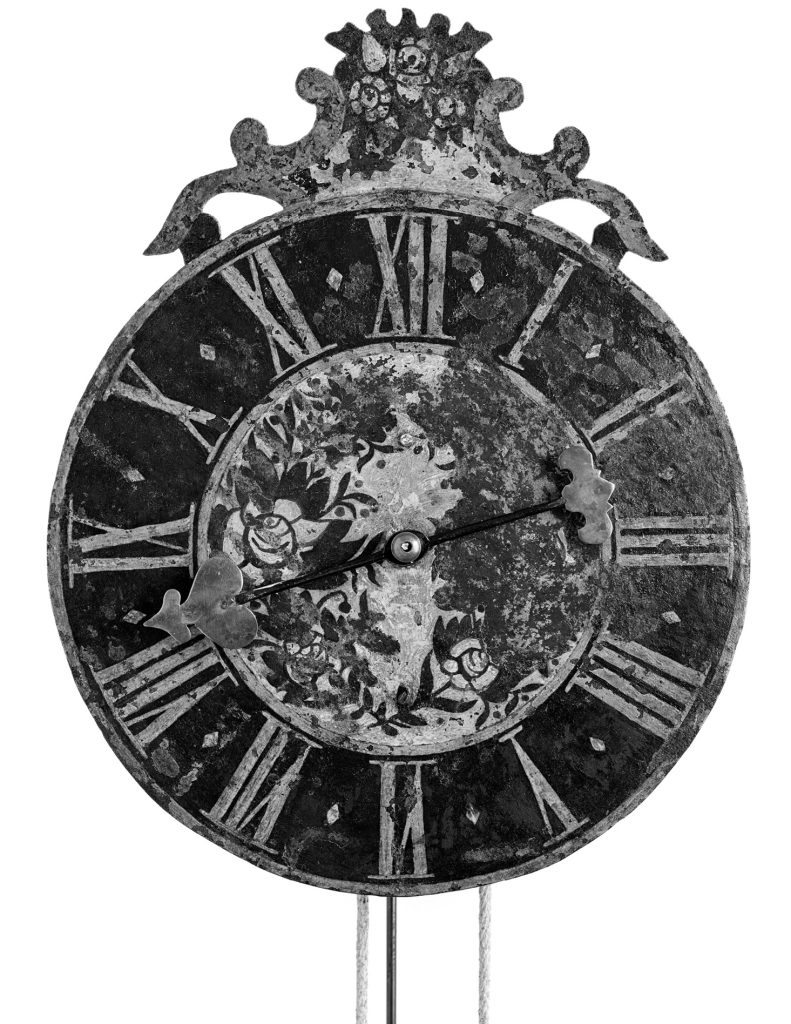Not a Kroeger: The Migration of a Werder Clock
Ernest Braun
“I have good news and bad news,” was what the late Arthur Kroeger said to me on the phone in June of 2013.1 The good news was that he had managed to repair my clock. But the bad news was that it was not a Kroeger clock. In fact, it turned out to be a round-face Werder design which, according to Mr. Kroeger, was no longer made after 1840. Moreover, the primitive face painting, the unusual one-hand mechanism, and the two-piece face design indicated that the clock was manufactured in Prussia by a non-Mennonite tradesman and then brought into the Russian empire, likely by a Mennonite family.

It is certain that the clock arrived in Manitoba aboard the S.S. Peruvian in July 1875 in the possession of the Wall family, either the son Johann (1848) as family legend suggests, or the widow of Johann Wall Sr. (1818), Susanna Krahn (1824), who had remarried Johann Mueller. Both son and mother ended up in Rosengart, West Reserve, where the clock kept time for over thirty years.
Some unknowns still exist: was the clock purchased new or second-hand? Was the clock brought into the family from a wife’s side at some point along the way? How did the clock end up in the possession of the Johann Wall family? If, in fact, the clock was purchased new by an ancestor of Johann Wall (1848), then the most likely scenario would be that his great-grandfather, Johann Wall (1768) of Danzig, acquired the clock prior to emigration in 1795, and that it was passed on to the succeeding generations of sons until it ended up on the ship with his great-grandson. If the clock was bought second-hand, then its provenance is impossible to guess. If the clock came via a wife’s family, then the trail leads back to Prussia and to an early acquisition date by either the unknown wife of Johann Wall (1768) or perhaps through Helena Redekopp (1798), the wife of his son Johann Wall (1793).

The clock can be placed with certainty in the hands of the Johann Wall family of Neuendorf, Khortitsa, prior to emigration. From Russia, the clock has continued to follow the migrations of Mennonites: first, with those coming to Manitoba who arrived in Rosengart, West Reserve. According to Susan Wall Funk (1927), the clock was inherited by her father, Isaak Wall (born in 1886 in Rosengart, West Reserve), one of the younger sons of Johann Wall (1848). The Genealogical Registry and Database of Mennonite Ancestry (GRANDMA) indicates that before 1909 the family moved to Saskatchewan, where several children were born. In about 1922, Isaak Wall took the clock to Mexico and it kept time for their family in Blumenhof, Swift Colony. In 1936 they returned to Manitoba, living in the Morris area, and later in the Plum Coulee district. Upon the death of Isaak Wall in 1946, the clock ended up with his daughter Mary Wall, who eventually gave it to her sister, Justina (Wall) Doerksen, the youngest in the family. Somehow, during that time, maybe during a move, the pendulum was lost. Susan Wall Funk commented that it had been fairly worn already at that time but was still serviceable. The last direct descendant to own the clock was Susan Wall Funk, who lived near Grunthal with her husband Jacob. During the years in Grunthal, a new pendulum was constructed by John Broesky. In the 1990s, the Funks sold their place and moved to Kleefeld. Orlando Hiebert, a relative of both Susan Wall Funk and her husband Jacob Funk, purchased the clock at auction. Ernest Braun, Tourond, bought the clock from Orlando in fall of 2012 and took it to Arthur Kroeger to be repaired.
Today the clock is part of “The Art of Mennonite Clocks,” the new exhibit in the Gerhard Ens Gallery at Mennonite Heritage Village (MHV), jointly sponsored by the Kroeger Clocks Heritage Foundation and MHV. The exhibit is on display until April 2019.
The Journey of the Werder Clock
1875: Neuendorf, Khortitsa to Rosengart, West Reserve, Manitoba
Pre-1909: Rosengart to Saskatchewan (exact location unknown)
Ca. 1922: Saskatchewan to Blumenhof village, Swift Colony, Mexico
1936: Blumenhof, Swift Colony, Mexico back to Manitoba, Canada
Post-1950: Morris to Plum Coulee district
1994: Plum Coulee to Grunthal, Manitoba
Ca. 1994: Grunthal to Tourond, Manitoba
- A version of this article originally appeared in Mennonite Heritage Village’s blog “Village News” on May 26, 2018, www.mysteinbach.ca/blogs/8935/history-of-a-werder-clock/. It is reprinted with permission from the author and from Mennonite Heritage Village. ↩︎
